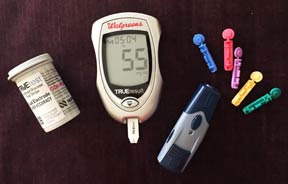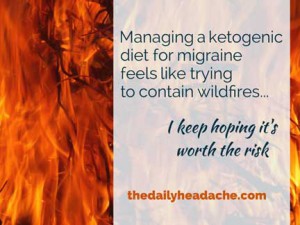I’ve told you about my difficulties starting a ketogenic diet for migraine and have tried to assess whether it is working for me, but haven’t told you how the diet works or why I decided to try it. Here’s a comprehensive introduction to using a ketogenic diet for migraine. It’s based on five months of research and more than three months of living with the diet.
Why a ketogenic diet?
Diet and headache was one of the presentations at the American Headache Society conference last November. Topics included biogenic amines (including tyramine and histamine), MSG, food allergies (actual immune responses rather than food sensitivities), gluten, low fat diets, a ketogenic diet, a high omega-3/low omega-6 diet, and a low-sodium diet. The research on a ketogenic diet for migraine was small and the results weren’t overwhelming. But I’d tried almost everything else the presenter mentioned and was feeling desperate. In the last couple years, I’ve heard more anecdotal evidence of it being effective for migraine and my naturopath recommended I look into it.
This was not my first flirtation with a ketogenic diet for migraine. I’ve looked into it multiple times over the last decade, but couldn’t find enough information to do one on my own. Until recently, the information was tightly controlled by doctors and dietitians who work with epilepsy patients. That’s because ketogenic diets are not nutritionally complete and can have serious side effects. As ketogenic diets have become really popular for weight loss, more information has become available. Simultaneously, some of the gatekeepers of the diet for epilepsy began to share details. Here’s what I’ve learned.
What’s a ketogenic diet?
Ketogenic diets shift the body’s fuel source from carbohydrates to fat. Burning fat for fuel causes the body to produce a substance called ketones, which is why the diets are called ketogenic (keto = ketones, genic = producing). When you produce ketones, you are in a state called ketosis and your metabolism mimics fasting or starvation. While that doesn’t seem like it would be a good thing, it works pretty well for treating epilepsy. Medically, ketogenic diets have been in use for epilepsy for nearly 100 years. They are increasingly being used for other conditions, like brain tumors, traumatic brain injuries, and autism, and have recently become popular for weight loss.
What are the different types of ketogenic diets?
 The classic medical ketogenic diet is 90% fat. It’s referred to as a 4:1 ketogenic diet—which means that for every four grams of fat, you eat one gram of protein+carbohydrate. This is not a high-protein diet; the goal is to just meet your recommended daily allowance of protein. Your carb count is whatever is leftover in the protein+carbohydrate equation.
The classic medical ketogenic diet is 90% fat. It’s referred to as a 4:1 ketogenic diet—which means that for every four grams of fat, you eat one gram of protein+carbohydrate. This is not a high-protein diet; the goal is to just meet your recommended daily allowance of protein. Your carb count is whatever is leftover in the protein+carbohydrate equation.
That’s the classic ketogenic diet, but there are many variations. For epilepsy, a 3:1 ratio tends to be the starting point for infants and teenagers. The Modified Atkins Diet is becoming increasingly popular for epilepsy, particularly for adults; it contains about 63% of calories from fat. Ketogenic diets for weight loss aren’t as strict in their breakdown. They range from about 60% to 75% calories from fat, 15% to 30% calories from protein, and 5% to 10% calories from carbohydrates. A quick internet survey found that the typical weight loss formula is 75% fat, 20% protein, and 5% carbohydrates.
[click on chart to enlarge]
What’s the best ketogenic diet for migraine?
It depends on the person. Some people see results at lower levels of fat, while others need higher amounts. Start with the lowest ratio you can and work your way up. Readers have reported success on the Modified Atkins Diet. I didn’t get noticeable relief until I worked up to a 3.5:1 ratio; my migraine attacks were worse when I increased to a 3.75:1 ratio (possibly because my blood sugar got too low).
How long does it take to see migraine improvement on a ketogenic diet?
Some people see improvement within a week of starting the diet or increasing their ratio. Almost everyone who sees improvement sees it in the first month. However, it takes about three months for the metabolism to fully shift, so some people don’t see results until a few months in.
It’s also important to manage adverse effects, which could worsen migraine attacks. I became hypoglycemic on the diet and hypoglycemia is a migraine trigger. Since I got the hypoglycemia (mostly) under control, my migraine attacks have been less severe. I can even eat small amounts without triggering an attack.
How long do you have to say on a ketogenic diet for migraine?
Kids with epilepsy can often be on the diet for a year or two, then return to a fairly normal (though generally lower carbohydrate) diet. My dietitian said it often functions as a sort of reset, but does not require a permanent change. Less is known about how adults respond to the diet. In one book I read, a woman in her early 20s with epilepsy had been on the diet nine years with no plan to stop. In naturopathic circles, it is often talked about as a lifelong change. For now, I think it’s an individual thing depending on the severity of your symptoms, your triggers, and how long your migraine attacks have been at their current level.
Why are medical ketogenic diets successful?
Almost all the research is on epilepsy. No matter the illness, the answer is that no one actually knows. Researchers have tested many hypotheses in the last century, but have not come to any conclusions. Ketosis is the probable cause, but that hasn’t been proven. Some researchers speculate that ketosis isn’t actually what’s responsible for improvements, it’s just the visible marker of some other physiological change. In the study on a ketogenic diet for migraine presented at AHS, the benefit could have come from weight loss rather than ketosis.
Why are the risks of ketogenic diets?
Ketogenic diets are not nutritionally complete. Carbohydrates are so restricted that you can’t eat enough vegetables and fruit to get adequate nutrition, so supplementation is imperative. Side effects can range from mild annoyance to death. Although highly unlikely, patients have died in multiple studies of ketogenic diets for epilepsy. Those deaths are typically attributed to hidden metabolic disorders, but it’s still important to be aware of the potential risk.
Please, please do a lot of research before jumping into a ketogenic diet and consider working with a dietitian. I’ve had a DIY approach to my diet for years and would have done this one on my own had I thought I could safely manage the 4:1 ratio without a dietitian. I’m so glad I didn’t. Even working with two dietitians and a naturopath, having blood work every month, and being hypervigilant, I’ve had issues with my blood becoming too acidic, hypoglycemia (that went undiagnosed for five weeks despite the best efforts of my health care team), and wildly fluctuating liver enzymes and inflammation markers. While my migraine attacks have been better on the diet, I overall feel less healthy than before I started it.
The popular version of the diet is less potentially damaging to health than the classic medical version, but I’ve heard enough scary stories from smart people who have educated themselves on the diet to urge anyone considering it to work with a dietitian, at least to start.
What about weight loss?
This diet is popular for weight loss for a good reason—it works. Because the diet mimics starvation, it suppresses hunger. And if you’re doing a 4:1 or 3:1 ratio, you have to weigh everything you eat, so you know exactly how many calories you’re getting. Even though my dietitian kept increasing my calorie intake, I lost 20 pounds unintentionally. My weight finally stabilized when I got to 2,300 calories a day—600 calories more than my dietitian thought I should need and more than I’ve eaten in years. I have yet to gain any of the weight back.
Learn More About Ketogenic Diets
Google “ketogenic diet” or search for it on Amazon and you’ll find information for bodybuilders and people who want to lose weight. That might be the best approach for you, but I recommend starting with the epilepsy-related information. It provides a foundation that explains the medical uses for the diet, is based in solid science (whereas much of the popular information is from not-quite-accurate interpretations of research), includes rational assessments of risks, and explains how to follow the diet in a way that doesn’t otherwise compromise your health. The following resources contain excellent information and were my sources for this post.
Even if you read nothing else, start with these:
More good resources include:
- The Charlie Foundation and Matthew’s Friends (Nonprofits started by parents of children with epilepsy who have benefited from ketogenic diets. Both sites have good introductions to the diets and helpful guidance. The Charlie Foundation’s information is written or reviewed by a leading dietitian in the field.)
- Fighting Back With Fat (A book by two moms who have implemented ketogenic diets to treat their children’s epilepsy. *Amazon affiliate link)

 I narrowly avoided bursting into tears at a Thai restaurant last night. Hart and I are in San Diego with a dear friend for the American Headache Society conference. I wanted to spend time with them and (inexplicably) thought watching them eat one of my favorite cuisines wouldn’t be a problem. The wonderful smells hit me half a block from the door. I lasted long enough to snag a table while Hart and our friend ordered, then jumped up and nearly ran to get away from the reminder of how much I’m missing with these endless
I narrowly avoided bursting into tears at a Thai restaurant last night. Hart and I are in San Diego with a dear friend for the American Headache Society conference. I wanted to spend time with them and (inexplicably) thought watching them eat one of my favorite cuisines wouldn’t be a problem. The wonderful smells hit me half a block from the door. I lasted long enough to snag a table while Hart and our friend ordered, then jumped up and nearly ran to get away from the reminder of how much I’m missing with these endless 

 But is the diet helping??? I inadvertently edited out the answer to the question many of you were wondering when I wrote about the ketogenic diet for migraine last week. The answer is a resounding maybe. I have not achieved my primary goals—eating or drinking anything but water still triggers a migraine attack and I still eat only once a day. But small improvements are increasing my quality of life.
But is the diet helping??? I inadvertently edited out the answer to the question many of you were wondering when I wrote about the ketogenic diet for migraine last week. The answer is a resounding maybe. I have not achieved my primary goals—eating or drinking anything but water still triggers a migraine attack and I still eat only once a day. But small improvements are increasing my quality of life.